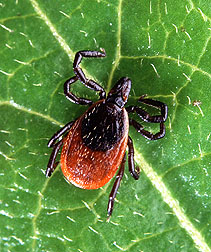This page has been archived and is being provided for reference purposes only. The page is no longer being updated, and therefore, links on the page may be invalid.
|
Read the magazine story to find out more. |
U.S. Scientists Help Scottish Counterparts Quash TicksBy Alfredo FloresApril 22, 2004 Members of the Game Conservancy Trust (GCT) in central Scotland have been tapping the expertise of Agricultural Research Service scientists in Kerrville, Texas. Why? Because disease-carrying ticks have been plaguing the Scottish red grouse, the most popular game bird in a nation where hunting on large estates is both economically important and a cherished tradition. Entomologist Mat Pound and agricultural engineer Allen Miller, at the ARS Knipling-Bushland U.S. Livestock Insects Research Laboratory in Kerrville, are well known for their research to control ticks that feed on white-tailed deer and other wild, hoofed mammals. The scientists have developed several control methods, including an automatic pesticide-dispensing device and a safe and efficient deer capture handling system. These offer potential solutions to the problem of controlling the blacklegged and lone star ticks that transmit the viruses that cause Lyme disease, human ehrlichioses, human babesiosis and other diseases. In Scotland, disease-carrying ticks have become an increasing problem on large estates, where red deer populations are thriving. The ticks feed on the deer, as well as on mountain hares, usually entering the estates on the deer. Some drop off and eventually feed on hares, becoming infected with a virus harbored by the hares. Later, if infected ticks feed on chicks of the Scottish red grouse, they transmit the virus to them. In the spring of 2003, Scottish scientists trapped and treated adult red grouse with pesticide-impregnated wing-tags and leg-bands developed at the ARS Kerrville lab. The scientists hoped that the treatments developed by ARS would prevent ticks from biting newly hatched nestlings. In August, data were collected that showed red grouse numbers had increased significantly from the previous year. Read more about this research in the April 2004 issue of Agricultural Research magazine. ARS is the U.S. Department of Agriculture's chief scientific research agency. |

